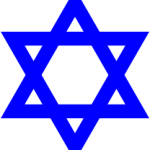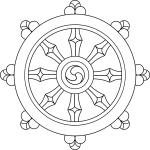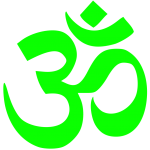
[Wikimedia/Fibonacci (public domain)]
24:40 And when he had said this, he showed them his hands and his feet.
24:41 While in their joy they were disbelieving and still wondering, he said to them, “Have you anything here to eat?”
24:42 They gave him a piece of broiled fish,
24:43 and he took it and ate in their presence.
This provides a great opportunity to talk about symbols from the various religious traditions. You can start with the Christian cross, but since this story mentions fish, you can also tell kids about early Christians using the fish as a secret symbol to mark meeting places and tombs. Early Christians may also have used the fish symbol to identify one another.
The other major world religions also have symbols associated with them. In Judaism, there is the Star of David. In Buddhism, there is the dharmachakra, usually depicted as a wheel with 8 spokes. And in Hinduism, there is the written symbol for Om/Aum.
All three symbols can easily be drawn by kids. For the Star of David, have them draw one triangle. Then, have them draw another “upside-down” triangle on top of the first one. (Apologies…the tips on the very top and very bottom of this image are cut off.)
For the dharmachakra, have them draw a small circle within a larger circle. Then, have them draw a “cross” and an “X” through the circles. Now, count the 8 spokes!
For the Om/Aum symbol, have them draw a backwards 3, then connect an “0” to it, but remind them not to close the “o” all the way. Have them add a little semi-circle at the top, and finally, have them draw a little dot in the center of the “bowl.”
The symbol for Sikhism, known as the Khanda, is a little more complex, but it can also be drawn by kids.

(public domain)]
In our experience, kids love to learn about these symbols, and it makes the point that many religious traditions, like Christianity, have symbols. Having the kids, themselves, draw the symbols helps demystify the images. The symbols make more sense after breaking them apart a bit and drawing them. Plus, it teaches kids that it’s OK to draw them. Click here for more religious symbols or more information about religious symbols.
Interfaith Sunday School is a weekly blog offering tips for sharing information about the world’s faith traditions to kids. Posts are published on Wednesdays and focus on one of the Revised Common Lectionary readings for the upcoming Sunday. Questions? Contact us at vicki@worldreligions4kids.com.


